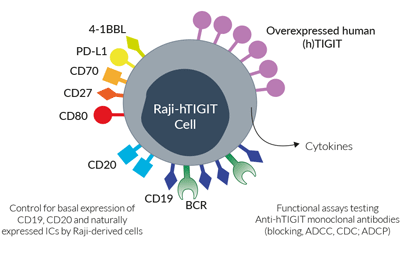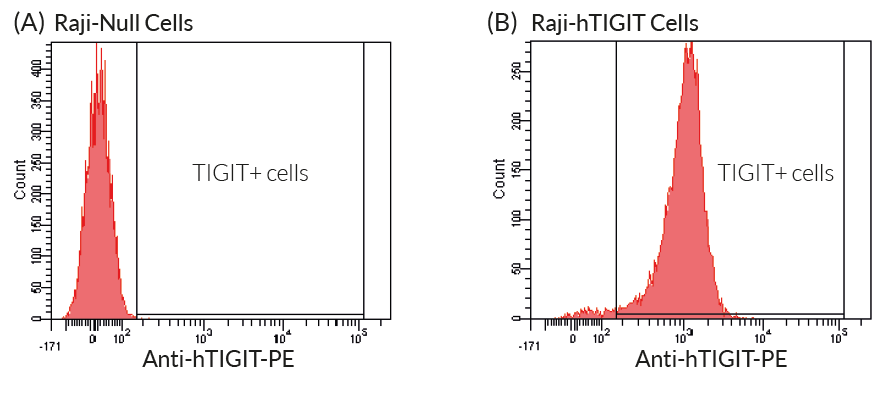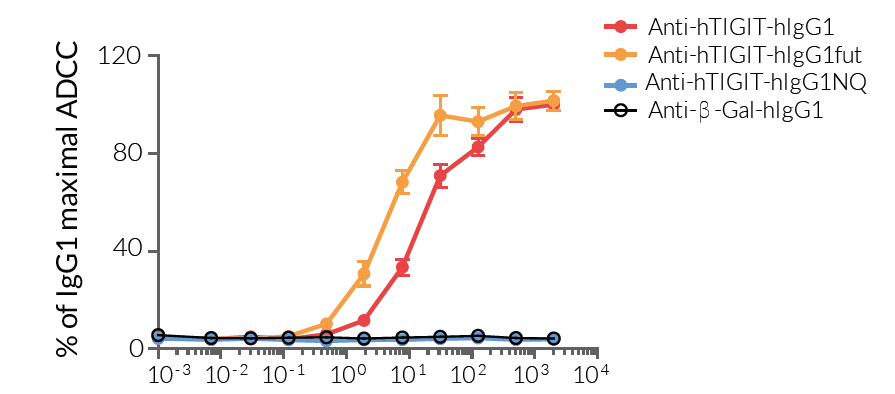Human TIGIT-expressing Raji Cells
| Product | Unit size | Cat. code | Docs. | Qty. | Price | |
|---|---|---|---|---|---|---|
|
Raji-hTIGIT Cells Human lymphoblast cells - ADCC TIGIT Target Cells |
Show product |
3-7 x 10e6 cells |
raji-htigit
|
|
||
|
Raji-hTIGIT vial Additional cell vial |
Show product |
3-7 x 10e6 cells |
raji-htigit-av
|
Notification: Reference #raji-htigit-av can only be ordered together with reference #raji-htigit.
Human TIGIT-expressing B cells
Raji-hTIGIT cells were developed from the Raji cell line, a human B lymphocyte-derived cell line. Raji cells have been successfully used as target cells in human effector studies such as antibody-dependent cellular cytotoxicity (ADCC), either with peripheral blood mononuclear cells, natural killer (NK) cells, or T cell-derived Jurkat reporter cells.
TIGIT (T cell immunoglobulin and ITIM domain) is an inhibitory checkpoint that has been implicated in tumor immunosurveillance. TIGIT is specifically expressed on immune cells including natural killer (NK) cells and activated T cells [1]. TIGIT binds to CD155 (PVR) and CD112 (PVRL2, nectin-2), which are expressed on antigen‑presenting cells (APCs) and a variety of non-hematopoietic cells (e.g. tumor cells) [1,2]. Upon binding to its ligand, TIGIT inhibits a number of signaling pathways, leading to a strong reduction of NK cytotoxicity, and blockade of T cell activation, proliferation, and effector functions [2,3]. The blockade of TIGIT is highly favorable in cancer immunotherapy due to its low expression in peripheral lymphoid organs, its established synergy with other co-inhibitory immune checkpoints, and its ligands being widely expressed on tumor cells [1,2].
Features of Raji-hTIGIT cells:

Surface expressed markers and ICs in Raji-hTIGIT cells
- Stable overexpression of the human TIGIT gene
- Characterized by a number of cell-surface expressed markers including the B cell receptor (BCR), CD19, and CD20
- Constitutive expression of various immune checkpoints (ICs) such as CD27, CD70, CD80, PD-L1, and 4-1BBL
- The stability for 20 passages following thawing has been verified
Applications for Raji-hTIGIT cells:
- Target cell line for ADCC assays using InvivoGen's Jurkat-Lucia™ NFAT-CD16 cells
- Target cell line for cell toxicity assays using NK or CAR-T cells
- For use in the development of other functional assays
Validation of Raji-hTIGIT cells:
- Overexpression of TIGIT verified by flow cytometry
- Functionally tested as target cells in ADCC assays using anti-human TIGIT mAbs and Jurkat-Lucia™ NFAT-CD16 cells
- Guaranteed mycoplasma-free
References:
1. Solomon, B. L. et al, 2018. TIGIT: a novel immunotherapy target moving from bench to bedside. Cancer Immunol Immunother 67, 1659-1667.
2. Anderson, A.C. et al. 2016. Lag-3, Tim-3, and TIGIT: Co-inhibitory Receptors with Specialized Functions in Immune Regulation. Immunity 44, 989-1004.
3. Joller, N. et al. 2011. Cutting edge: TIGIT has T cell-intrinsic inhibitory functions. J Immunol 186, 1338-1342.
Specifications
Antibiotic resistance: Blasticidin
Growth medium: IMDM, 2 mM L-glutamine, 25 mM HEPES, 10% heat-inactivated fetal bovine serum (FBS; 30 min at 56 °C), 10 μg/ml Blasticidin, Pen-Strep (100 U/ml-100 µg/ml)
Test medium: IMDM, 2 mM L-glutamine, 25 mM HEPES, 10% heat-inactivated FBS, Pen-Strep (100 U/ml-100 µg/ml)
Quality control:
- Human TIGIT expression has been verified by flow cytometry.
- Induction of antibody-dependent cellular cytotoxicity (ADCC) has been validated using InvivoGen’s anti-hTIGIT-hIgG1 antibody and Jurkat-NFAT Lucia™ CD16 reporter cell line.
- The stability for 20 passages following thawing has been verified.
- Raji-hTIGIT cells are guaranteed mycoplasma-free.
Contents
- 3-7 x 106 Raji-hTIGIT cells in a cryovial or shipping flask.
- 1 ml of Blasticidin (10 mg/ml). Store at 4 °C or at -20 °C.
- 1 ml of Normocin™ (50 mg/ml). Normocin™ is a formulation of three antibiotics active against mycoplasmas, bacteria, and fungi. Store at -20 °C.
IMPORTANT: If cells are shipped frozen (i.e. in a cryovial) and are not frozen upon arrival, contact InvivoGen immediately.
![]() Shipped on dry ice (Europe, USA & Canada)
Shipped on dry ice (Europe, USA & Canada)








